List of Contents
Exoskeleton Market Size and Forecast 2025 to 2034
The exoskeleton market size is 496.87 million in 2024 and is projected to cross around 2313.89 million by 2034, expanding at a solid CAGR of 16.63% between 2025 and 2034. The rising use of robotic exoskeletons in military and defense contributes to the growth of the market.
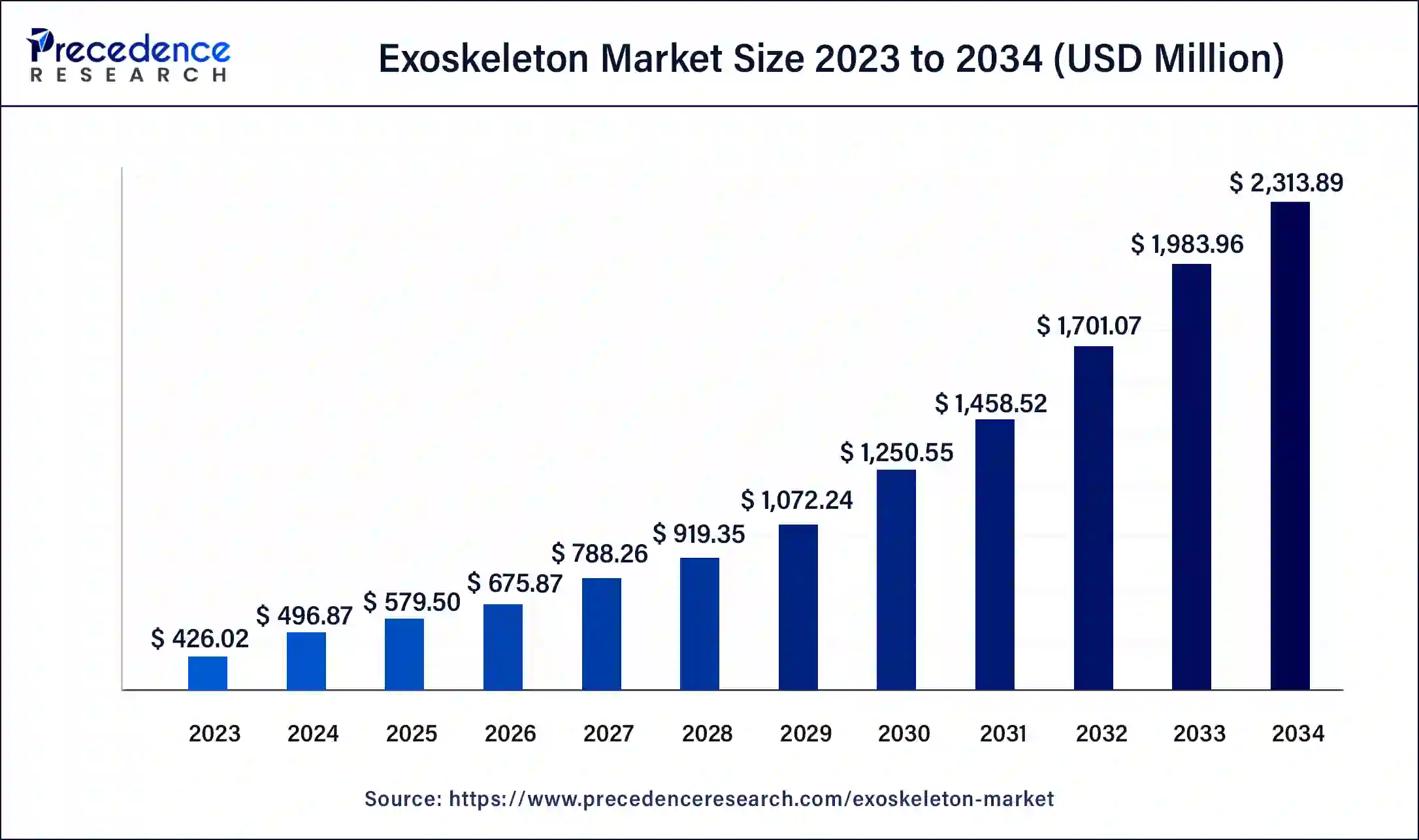
Exoskeleton Market Key Takeaways
- North America dominated the exoskeleton market with the largest market share of 47% in 2024.
- Asia Pacific is estimated to be the fastest-growing during the forecast period of 2025 to 2034.
- By mobility, the mobile captured the largest market share of 63% in 2024 and volume share of 64%.
- By technology, the powered segment dominated the market with the highest market share of 74% in 2024.
- By technology, the non-powered segment is anticipated to be the fastest-growing during the forecast period.
- By extremity, the lower body segment generated over 44% of market share in 2024.
- By extremity, the upper body segment is estimated to be the fastest-growing during the forecast period.
- By end-use, the healthcare segment contributed more than 51% of market share in 2024.
- By end-use, the industry segment is anticipated to be the fastest-growing during the forecast period.
U.S. Exoskeleton Market Size and Growth 2025 to 2034
The U.S. exoskeleton market size was exhibited at USD 175.15 million in 2024 and is projected to be worth around USD 824.32 million by 2034, poised to grow at a CAGR of 16.75% from 2025 to 2034.
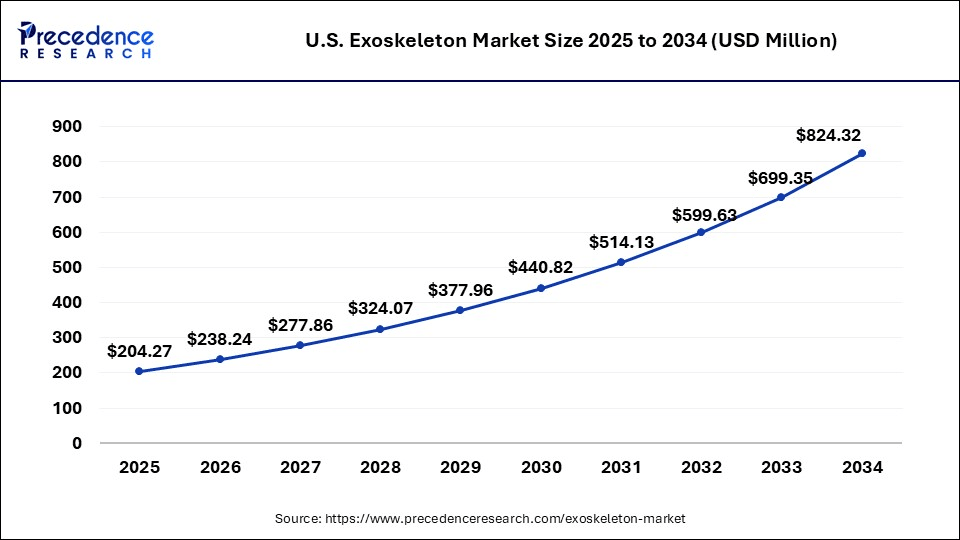
North America dominated the exoskeleton market in 2024. The increasing public & private support, availability of advanced technology products, increasing number of collaborations & partnerships with key players, and increasing investment in research activities contribute to the growth of the market. The availability of private investors, the increasing human augmentation in military and services, the broad presence of key players in the market, the rapidly increasing senior population, and the increasing disposable income help to grow the market in the Asia Pacific region.
- In December 2023, the production version of the GR-1 humanoid robot was launched by Fourier Intelligence, a Singapore-based company. This company has been manufacturing rehabilitation devices and exoskeletons since 2017.
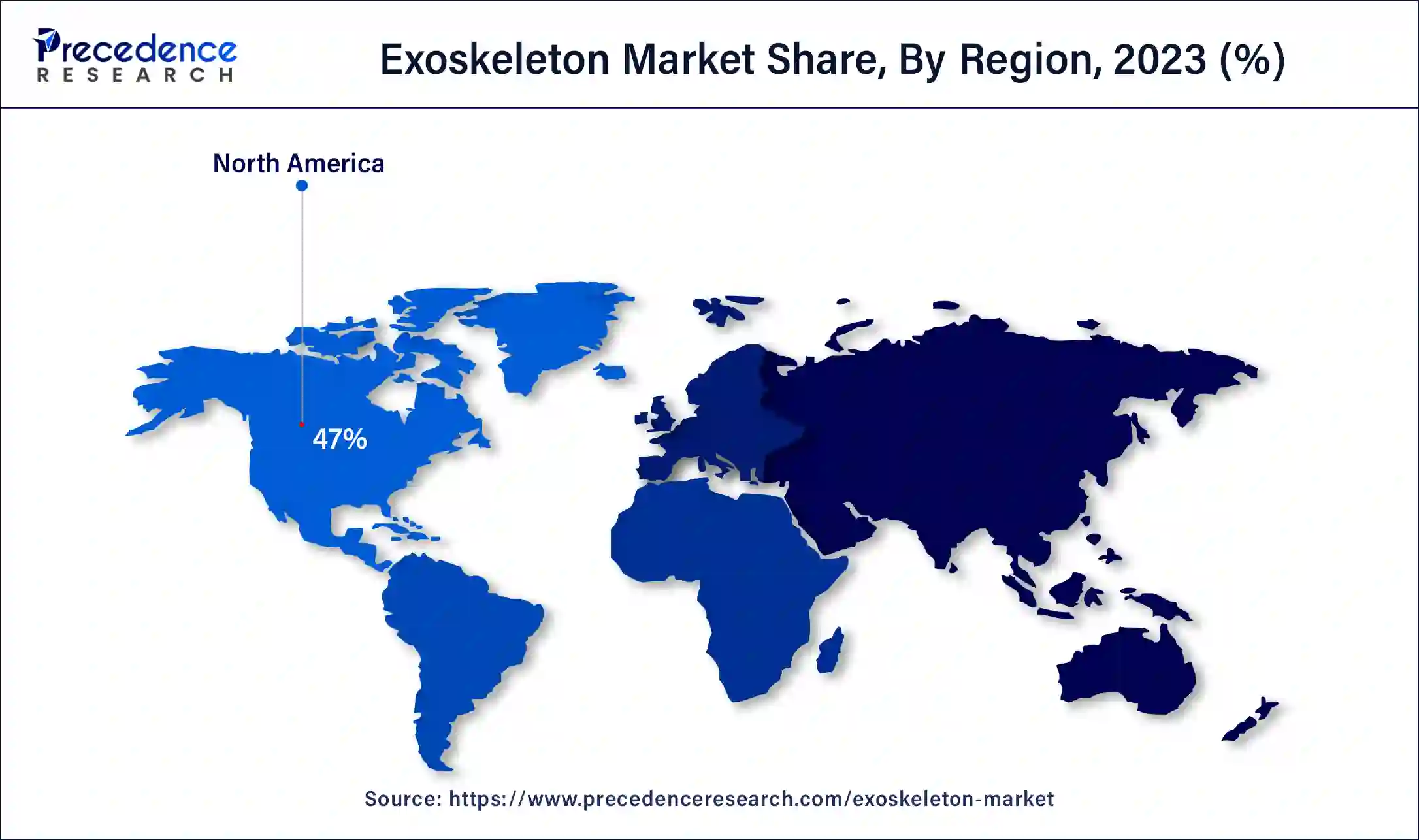
Asia Pacific is estimated to be the fastest-growing during the forecast period of 2025-2034. The increasing number of patients requires rehabilitation support, which contributes to the growth of the exoskeleton market in the Asia Pacific region. Advancing and developing healthcare infrastructure and the availability of government funding and support are driving the Asia Pacific region's growth of the market. Continuous economic development in countries like India, China, and Japan helps the growth and development of the market.
- In March 2023, India's first homegrown exoskeleton and quadruped robots were launched by a Hyderabad-based company, Svaya Robotics, in collaboration with two DRDO labs, the R&DE (Research & Development Establishment in Pune) and Defense Bio-engineering & Electro Medical Laboratory in Bengaluru (DEBEL).
Market Overview
The exoskeleton market includes the complete industry involved in the manufacturing, developing, and commercializing of exoskeletons specially designed to enhance individuals' physical disabilities. The exoskeleton is a rigid covering found on many animals, mainly invertebrates like mollusks and invertebrates. Exoskeletons have many benefits, including promoting a high level of diversity, promoting strength & longevity, protecting organisms from desiccation & acting as a barrier, preventing dehydration and getting too wet, etc., contributing to the growth of the market.
Exoskeleton Market Growth Factors
- The exoskeletons have many benefits, including promoting a high level of diversity, promoting strength and longevity, protecting organisms from desiccation & acting as a barrier to contributing to the growth of the exoskeleton market.
- It helps to protect against accidental damage to the soft internal organs and attack from predators.
- It helps to prevent dehydration and getting too wet, increasing the leveraging of the animal and protecting the animal against abrasion or physical damage.
- It allows complex movements due to jointed appendages, returning functions in the case of injury and paralysis and providing support.
What are the benefits of AI in the Exoskeleton?
The integration of artificial intelligence (AI) in exoskeletons contributes to the growth of the exoskeleton market, mainly in the fields of robotics and healthcare. The advantages of an exoskeleton include improved surgical precision. AI can help surgeons to perform critical orthopedic surgeries with high precision. It also includes the benefits of reduced healthcare costs and enhanced efficiency of medical services. AI-based exoskeletons provide rehabilitation and recovery for patients, predictive maintenance, personalized treatment plans, and improved diagnostics that contribute to the growth of the market.
- In June 2024, North Carolina State University Researchers created an AI-trained robotic exoskeleton that helps to improve human movements by users running, walking, and climbing stairs. It may have future applications, including for people with disabilities in industrial and military work.
Market Scope
| Report Coverage | Details |
| Market Size by 2034 | USD 2,313.89 Million |
| Market Size in 2025 | USD 579.50 Million |
| Market Size in 2024 | USD 496.87 Million |
| Market Growth Rate from 2024 to 2034 | CAGR of 16.63% |
| Largest Market | North America |
| Base Year | 2024 |
| Forecast Period | 2025 to 2034 |
| Segments Covered | Mobility, Technology, Extremity, Structure, End-use, and Regions |
| Regions Covered | North America, Europe, Asia-Pacific, Latin America, and Middle East & Africa |
Market Dynamics
Driver
Increasing road accidents and military demand for exoskeletons
The exoskeleton is like a body's architectural scaffolding, which is important. Exoskeleton applications in rehabilitation and treatment. The exoskeleton plays an important role in support and movement, which helps the exoskeleton market grow. The exoskeleton acts as a bodyguard. It protects organs like the liver, heart, and lungs. From physiotherapy to emergency services and in the military, exoskeletons may enhance the physical capabilities of warfighters and enable them to lift heavier objects, run faster, and reduce strain on the body at the time of physical operations.
Restraint
Risks of Exoskeleton
The risks of the exoskeleton include structural limitations, energy expenditure, development and growth limitations, limited protection, vulnerability to injury, and high costs of product acquisition and R&D. It provides outstanding protection to the main organs and does not provide much protection to the other body areas. These factors can hamper the growth of the exoskeleton market.
Opportunity
Research & advanced technologies of exoskeleton
The exoskeletons are the internal frameworks that play an important role in many organisms and are subject to research and technological advancements. The advantages of the exoskeleton include force transmission, muscle attachment sites, and growth flexibility. It helps to enhance the running and walking economy with an exoskeleton; innovations like human exoskeleton interface design, mechatronic designs, off-board actuators, physiologically informed joint targeting, etc., are the opportunities for the growth of the exoskeleton market in the future.
- In July 2024, $5000 exoskeleton hiking pants inspired by mountain goats were launched by Arc'teryx and Skip.
Health benefits by using the exoskeleton of ReWalk Robotics
Studies and user surveys have shown that regular exoskeleton-assisted walking programs result in a range of health advantages for people who suffer from spinal cord injury.
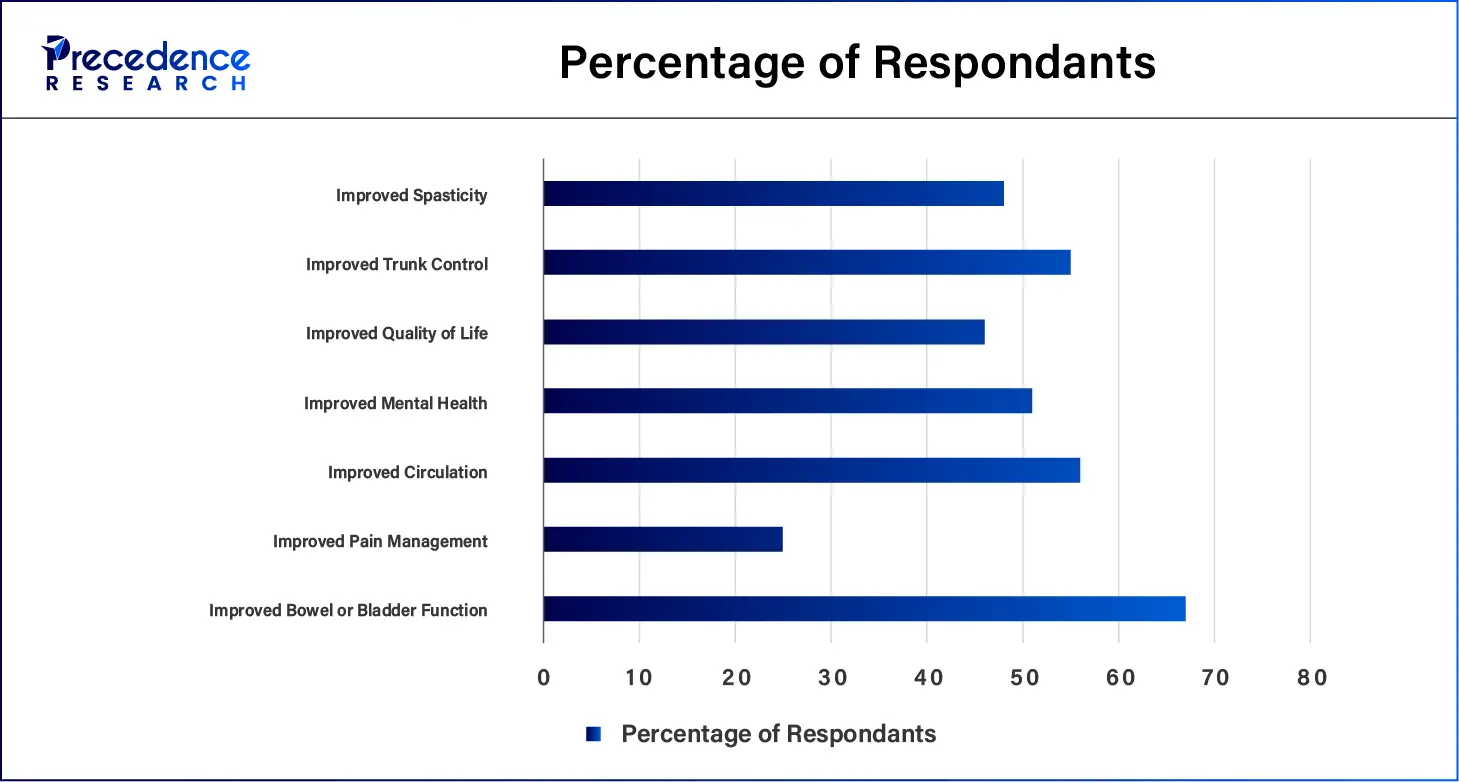
Mobility Insights
The mobile segment dominated the exoskeleton market in 2024 and is expected to be the fastest-growing segment during the forecast period. The benefits of a mobile exoskeleton include streamlined workflow and productivity, active patient engagement, and infection control. Mobile exoskeletons are wearable robotics designed for movement and freedom. Mobile exoskeletons enable users and exoskeletons to move around freely. Exoskeletons provide a boost for recovering from injury and dealing with mobility challenges. Mobile exoskeletons are battery-powered awesomeness, autonomy, and independence, and work smarter.
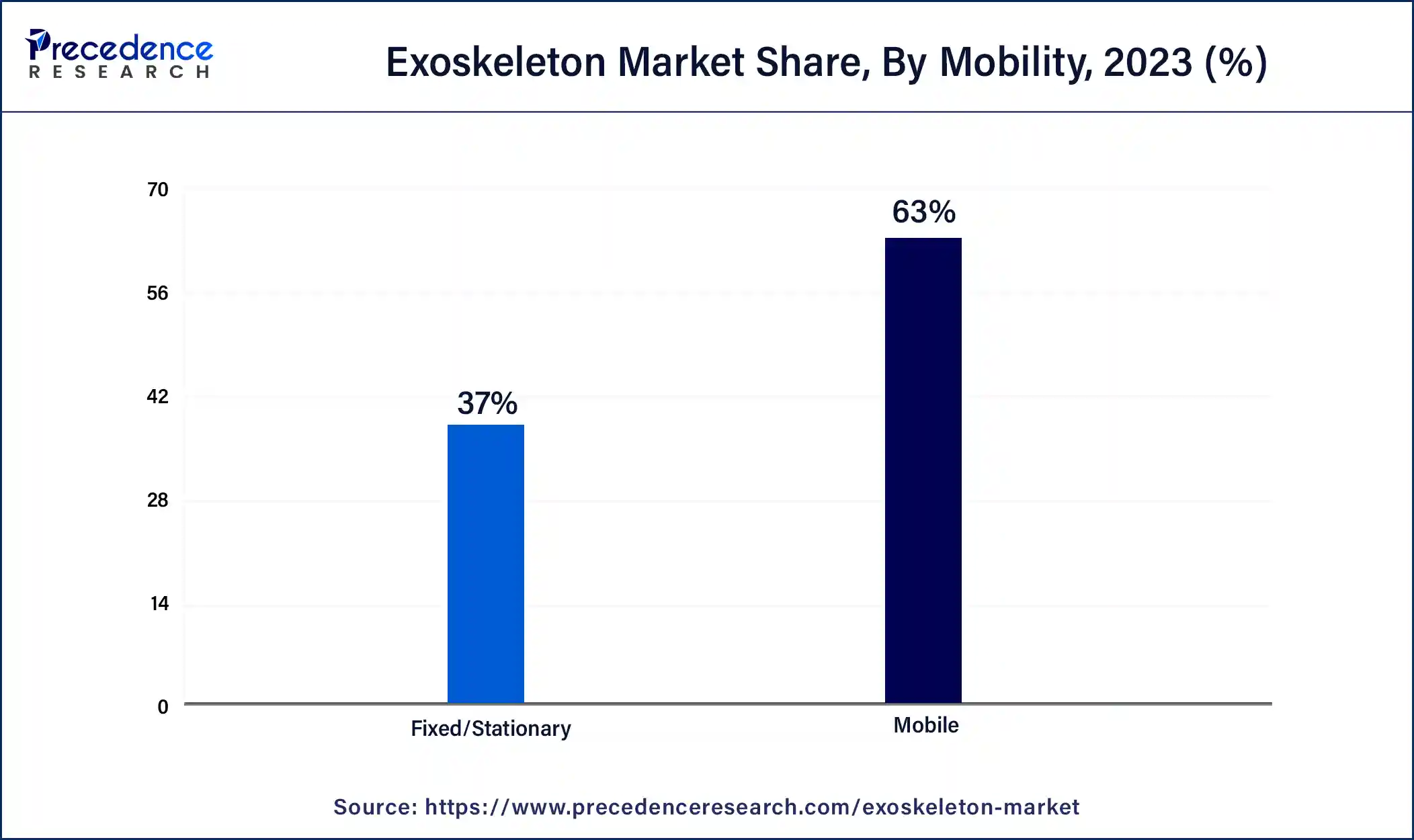
- In October 2023, in the United States, a commercial operation of the exoskeleton, mobility exoskeleton Atlante X, was launched by Wandercraft SAS, a mobility exoskeleton developer. This helps the millions of people with mobility impairments. The Atlante X is beneficial for neurological impaired patients, including those recovering from motor neuron disease, stroke, and spinal cord injuries.
Technology Insights
The powered segment dominated the exoskeleton market in 2024. The powered skeleton is an early version of the Iron Man suit, correcting posture, dispersing weight, and improving stability to enhance endurance and increase productivity at the time of eliminating injuries. The application of exoskeleton in the supply chain and manufacturing. The powered exoskeleton helps to increase productivity, enhance worker safety, and eliminate fatigue.
Active or powered exoskeletons need some form of energy, like a battery pack, for activating pneumatics, hydraulics, or motors. Key components in powered exoskeletons include elastic fabrics, metal, and carbon fiber, which are common building materials for comfort and mobility without sacrificing strength. Powered exoskeletons also require control strategies, algorithms, mechanical structures, actuators, and sensors to explain users' intentions and support or initiate actions. They use 3 modules comprising sense, execution, and decision to actuate, analyze data, and gather data on the exoskeleton according to the desired tasks.
- In May 2023, AI-powered wearable exoskeletons do the heavy lifting that endows superhuman strength. It was developed by German Bionic, an Augsburg-based startup. These exoskeletons are a little more modest than Iron Man's.

The non-powered segment is anticipated to be the fastest-growing during the forecast period. The benefits of passive or non-powered exoskeletons include increased employee productivity, reduced number of days taken off work due to injuries, reduced healthcare use, and decreased occupational injury incidences. Non-powered exoskeletons are normally less complex, lighter, and do not require an external power source. They may be used to alleviate fatigue, improve posture in repetitive tasks, and reduce strain in certain body parts.
- In February 2022, the World's first personal self-balanced exoskeleton, named Atalante, was launched by Wandercraft, a French health tech startup. This is a totally self-reliant walking system with the goal of providing new care for patients by allowing them to move around in a crutch-free, hands-free, realistic manner.
Extremity Insights
The lower body segment dominated the exoskeleton market in 2024. The growing adoption of exoskeleton products, the increase in lower body disability incidences, and the increase in investments have helped the growth of the market. The growing adoption of exoskeleton products by paralyzed patients and senior populations for mobility and weight-bearing capabilities. Additionally, military and defense personnel use lower-body solutions to help soldiers and enhance their motion and speed. The benefits of the lower body exoskeleton include muscle power and injury prevention, bone health and metabolism, enhanced performance, core stability, and posture, and it helps with heart health and blood circulation.
- In February 2024, the new robotic exoskeleton for lower limbs, named TWIN, was designed and developed by Rehab Technologies IIT-INAIL, the joint laboratory between the Italian Institute of Technology and the prosthetic center of INAIL that may enable patients to wear it more easily to stand up, maintain upright position, sit, and walk.
The upper body segment is estimated to be the fastest-growing during the forecast period. The benefits of the upper body exoskeleton include performance boost, recovery support, cross-training with upper body exercises boost efficiency, and also reduced risk of injury. It also includes the benefits of warm-up efficiency, core strength, range of motion, muscle attachment, and support and protection for our upper body, which helps the growth of the exoskeleton market.
- In April 2022, the new and improved Shoulder upper body exoskeleton named ‘Ottobock Shoulder' was launched by Ottobock, a German manufacturer. These exoskeletons are available on the company's website, and pricing starts at US$4,990.
End Use Insights
The healthcare segment dominated the exoskeleton market in 2024. In the healthcare sector, several studies exist that help to examine many exoskeletons to provide back support to healthcare professionals. Benefits of the exoskeleton in healthcare include structural support, growth, and protection of internal organs like the liver, kidneys, heart, and lungs from accidental knocks and bumps.
- In August 2024, to assess the capacity for an exoskeleton that helps to benefit healthcare workers, nurses, and carers like occupational therapists and physiotherapists, a European research project was launched, and more than €657,000 in funding has been provided.
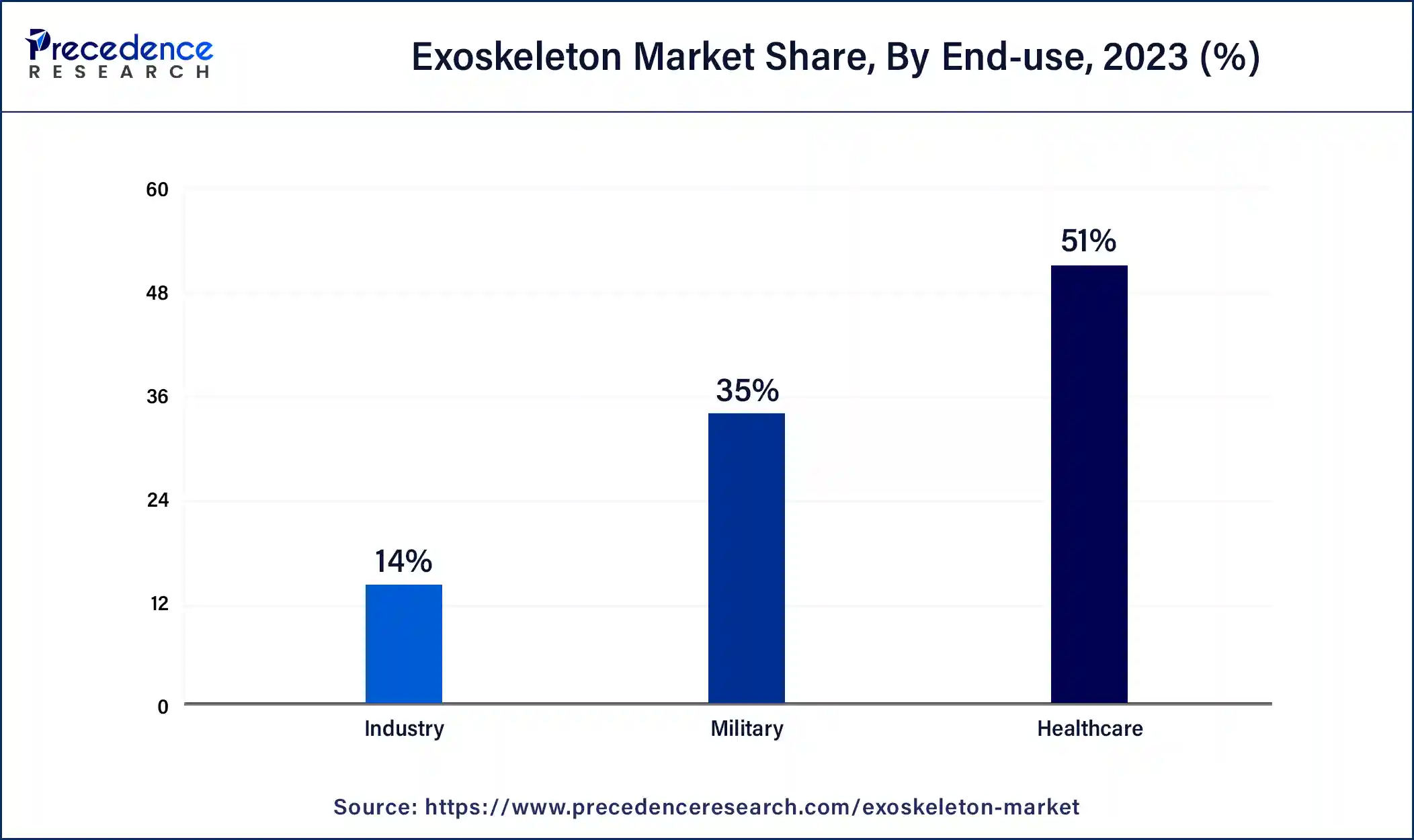
The industry segment is anticipated to be the fastest-growing during the forecast period. The benefits of industrial exoskeletons include safety, human augmentation, muscle magic, strength & size, etc., contributing to the growth of the exoskeleton market. The increasing rate of injuries and increasing awareness of exoskeleton technologies in many industrial applications contribute to the growth of the market.
- In September 2024, in America, the ExoActive EXO 18 HPC 4, 0 I-Plus exoskeleton for construction-related tradespeople was planned to be launched by Festool. These exoskeletons are wearable robotics that may be helpful for users by providing extra support and strength so users may move heavy patients safely and hike hills faster.
Exoskeleton Market Companies
- ActiveLink (Panasonic Corporation)
- Cyberdyne, Inc.
- ReWalk Robotics
- RB3D
- Rex Bionics Plc.
- Suit X
- Lockheed Martin Corporation
- Hocoma
- Ekso Bionics
- Sarcos
- Parker Hannifin
- Ottobock SE & Co. KGaA
- Noonee
- Levitate Technologies, Inc.
- Hyundai Motor Company
- Gogoa
- B-Temia
- Bionik Laboratories Corp.
Recent Developments
- In April 2024, a drive systems portfolio designed for modern robotics applications was launched by Maxon Group. This also includes mobile manipulators, exoskeletons, quadrupeds, or humanoids.
- In May 2024, a comprehensive 360° Human Augmentation Exoskeleton Platform at VivaTech was launched by German Bionic. This new platform is designed to improve everyday life, ensuring that every individual may receive with greater safety, ease, and comfort.
Segments Covered in the Report
By Mobility
- Mobile
- Fixed/Stationary
By Technology
- Powered
- Non-powered
By Extremity
- Upper Body
- Lower Body
- Full Body
By Structure
- Rigid Exoskeleton
- Soft Exoskeleton
By End-use
- Industry
- Military
- Healthcare
By Geography
- North America
- Asia Pacific
- Europe
- Latin America
- Middle East & Africa
For inquiries regarding discounts, bulk purchases, or customization requests, please contact us at sales@precedenceresearch.com
Frequently Asked Questions
Ask For Sample
No cookie-cutter, only authentic analysis – take the 1st step to become a Precedence Research client